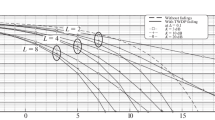Abstract
A method is proposed of evaluation of symbol and/or bit error probabilities for coherent receiving of multipositional signal constructions in communication channel with fadings, which are described with the help of classical and generalized models Multiple-Wave with Diffuse Power (MWDP) fading and of additive white Gaussian noise (AWGN). This method uses the hypergeometric functions of several variables.




Similar content being viewed by others
Notes
In scientific literature it is sometimes appeared incorrect coefficient before imaginary part of the characteristic function.
REFERENCES
N. V. Savischenko, Special Integral Functions Used in Wireless Communications Theory (World Scientific, Singapore, 2014).
M. Nakagami, ‘‘The \(m\)-distribution—A general formula of intensity distribution of rapid fading,’’ inStatistical Methods in RadioWave Propagation, Ed. by W. C. Hoffman (Pergamon, New York, 1960), pp. 3–36.
G. D. Durgin, T. S. Rappaport, and D. A. de Wolf, ‘‘New analytical models and probability density functions for fading in wireless communications,’’ IEEE Trans. Commun.50, 1005–1015 (2002).
R. Esposito and L. Wilson, ‘‘Statistical properties of two sine waves in Gaussian noise,’’ IEEE Trans. Inform. Theory 19, 176–183 (1973).
Yu. A. Brychkov and N. V. Savischenko, ‘‘A special function of communication theory,’’ Integral Transforms Spec. Funct. 26, 470–484 (2015).
Y. L. Luke, Mathematical Functions and their Approximations (Academic, New York, 1975).
A. P. Prudnikov, Yu. A. Brychkov, and O. I. Marichev, Integrals and Series, Vol. 2: Special Function (Gordon and Breach Science, New York, 1986).
A. P. Prudnikov, Yu. A. Brychkov, and O. I. Marichev, Integrals and Series, Vol. 3: More Special Function (Gordon and Breach Science, New York, 1990).
Yu. A. Brychkov, O. I. Marichev, and N. V. Savischenko, Handbook of Mellin Transforms (Chapman and Hall/CRC, Boca Raton, 2019).
Yu. A. Brychkov, Handbook of Special Functions: Derivatives, Integrals, Series and Other Formulas (Chapman and Hall/CRC, Boca Raton, FL, 2008).
H. Bateman and A. Erdèlyi, Higher Transcendental Functions (McGraw-Hill, New York, 1953), Vol. 2.
H. Exton, Multiple Hypergeometric Functions and Applications (Ellis Horwood, Wiley, Halsted, Chichester, 1976).
H. M. Srivastava and H. Exton, ‘‘On Laplace’s linear differential equation of general order,’’ Nederl. Akad. Wetensch. Proc., Ser. A 76, Indag. Math. 35, 371–374 (1973).
F. W. J. Olver, D. M. Lozier, R. F. Boisvert, and Ch. W. Clark, NIST Handbook of Mathematical Functions (Cambridge Univ. Press, Cambridge, 2010).
M. Abramowitz and I. A. Stegun, Handbook of Mathematical Functions with Formulas, Graphs, and Mathematical Tables, 10th ed. (U.S. Dep. Commerce—NBS, Gaithersburg, MD, 1972).
L. J. Slater, Confluent Hypergeometric Functions (Cambridge Univ. Press, London, 1960).
H. M. Srivastava and P. W. Karlsson, Multiple Gaussian Hypergeometric Series (Halsted Press, Chichester, 1985).
H. M. Srivastava and H. L. Manocha, A Treatise on Generating Functions (Halsted Press, Chichester, 1984).
Author information
Authors and Affiliations
Corresponding authors
Additional information
(Submitted by A. M. Elizarov)
Appendix A. PROBABILITY DENSITY FUNCTION FOR MWDP
Appendix A. PROBABILITY DENSITY FUNCTION FOR MWDP
Consider the integral
Since \(J_{\nu}\left(z\right)=\dfrac{\left(z/2\right)^{\nu}}{\Gamma\left(\nu+1\right)}_{0}F_{1}\left(\nu+1;{-}\dfrac{z^{2}}{4}\right)\) the equality (A1) can be converted to the form
After the change of variable \(t=\sigma^{2}x^{2}/2\) and simple transformations we obtain
Here we use the formula
which follows from the relations
where the Lauricella function is defined as
and the conluent function as
and
Remark 1. From the integral representation of the Lauricella function and identity \({}_{1}F_{1}\left(a,b;z\right)=e^{z}{}_{1}F_{1}\left(b-a,b;{-}z\right)\) with \(\sum_{j=1}^{n}|z_{j}|<1\), it follows that
Rights and permissions
About this article
Cite this article
Brychkov, Y.A., Savischenko, N.V. Application of Hypergeometric Functions of Several Variables in the Mathematical Theory of Communication: Evaluation of Error Probability in Fading Singlechannel System. Lobachevskii J Math 41, 1971–1991 (2020). https://doi.org/10.1134/S1995080220100066
Received:
Revised:
Accepted:
Published:
Issue Date:
DOI: https://doi.org/10.1134/S1995080220100066



